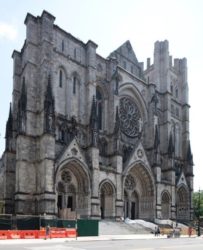
St. John the Divine Cathedral. Image Credit: LPC.
Unfinished cathedral, the largest in the world, designated a landmark for second time. On February 21, 2017, Landmarks commissioners voted to designate the St. John the Divine Cathedral and Close an individual City landmark. The cathedral, the seat of the Episcopal Diocese of New York, is the largest church in the United States, and the largest cathedral in the world. It stands at 1047 Amsterdam Avenue, in Manhattan’s Morningside Heights neighborhood.
The Landmarks Commission first held a hearing on the potential designation of the cathedral in 1966, and ultimately voted to designate the cathedral a City landmark in 2003. The designation was overturned by the City Council because it was limited to the cathedral’s footprint, and would allow for the development of the rest of the campus.
The Commission again added the cathedral to its calendar on July 19, 2016. This potential designation included six historic auxiliary buildings comprising the cathedral close.
Construction on the unfinished cathedral began in 1892, on property previously occupied by the Leake and Watts Orphan Asylum. The cathedral commenced construction under design by the firm Hein & LaFarge, who won the commission in a major architectural competition. The firm proposed an eclectic design, incorporating Gothic, Romanesque, and Byzantine styles. In 1916, a second construction phase began under architect Ralph Adams Cram, who led the design in a French Gothic direction. Following the completion of the nave and west front, construction of the towers began in 1979. Landmarks’ research department called the finely detailed cathedral “one of the most impressive architectural statements in the City.”
Of the additional six building which compose the landmark, the oldest dates to the site’s time as an orphanage The 1842 Greek Revival building is the oldest structure in Morningside Heights. The 1911 St. Faith’s House was built as part of a training school for deaconesses in a Collegiate Gothic style, as was the 1913 Choir School, constructed for the education of choirboys. The gothic Synod House dates 1914, and was built for a convention of the Protestant Episcopal Church. The Deanery and Bishop’s House were both designed by Cram.
At a December 6, 2016, hearing on the potential designation, church officials endorsed the designation. Dean Reverend James Kowalski said conversations with Landmarks had convinced him that designation would celebrate and provide stewardship for the cathedral’s “great architectural legacy.” Council Member Mark Levine spoke in support of designation, as did preservationists and Morningside Heights community groups.
Commissioners endorsed the designation enthusiastically. Commissioner Adi Shamir-Baron spoke of the significance of the unfinished nature of the cathedral, saying that designation would memorialize not just the cathedral’s past but also what it would become. Commissioner Michael Goldblum said the cathedral united two aspects of landmarking, both significant for its architecture and for its social and communal importance. Commissioner Wellington Chen said the St. John the Divine “transcends the ages,” and in the 300-year cycle of cathedral construction landmark designation would help pass on the cathedral’s “living legacy” to future generations.
Commissioners Diana Chapin and John Gustafsson shared personal reminiscences of the cathedral, with Gustafsson also commenting on the “drama” of the experience of the building.
Chair Meenakshi Srinivasan said designation of the complex would preserve the relationship between structures, and noted that the continuing evolution of the cathedral was a testament to the “agility of the landmarks law.” She said designation did not only maintain properties in a static state, but can also “look to the future.” Srinivasan thanked church leadership for their support of the designation, which she called “extremely important” to the City.
The vote was met with applause from the audience.
LPC: Cathedral Church of St. John the Divine and Cathedral Close, 1047 Amsterdam Avenue, Manhattan (LP-2585) (Feb. 21, 2017).
By: Jesse Denno (Jesse is a full-time staff writer at the Center for NYC Law).

